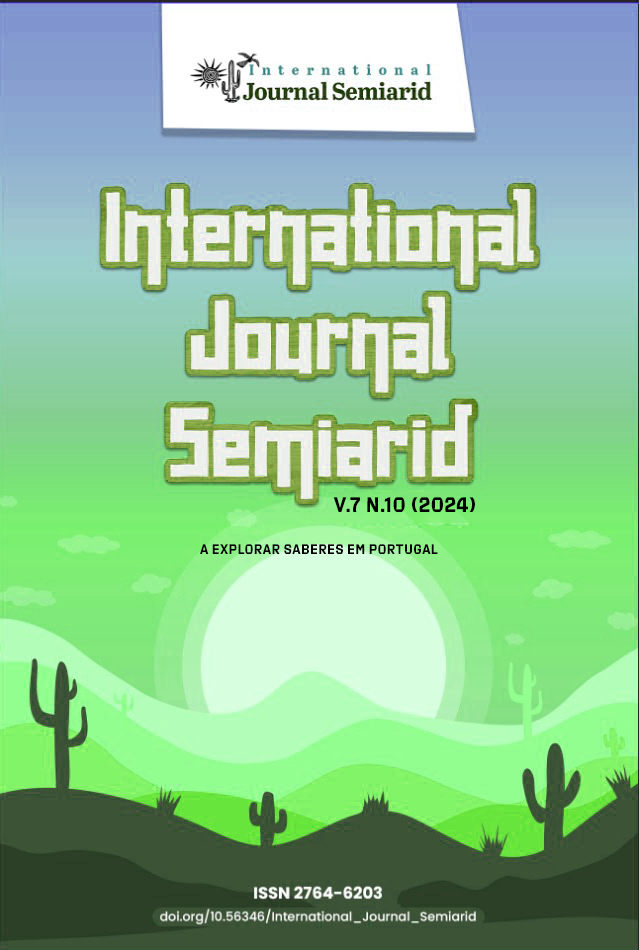WHAT DOES THE AIR SMELL LIKE? SENSORY ANALYSIS IN A MECHANICAL AND BIOLOGICAL URBAN WASTE TREATMENT UNIT
DOI:
https://doi.org/10.56346/ijsa.v7i10.292Keywords:
TMB, perceção sensorial, compostos químicos voláteis, COV, odorAbstract
Various volatile chemical compounds with an odour (or smell) are produced in waste management facilities. These compounds are perceived by those working in and visiting these facilities. In this study, sensory perception was used to detect odour compounds during a visit by university students to a mechanical and biological treatment facility in two consecutive years (2018 and 2019). For this purpose, a sensory perception survey was carried out at three different locations in the plant and the data were statistically analysed. Although the determination of total VOCs was within the required legal limits, the sensory perception made it possible to identify the compounds with the predominant odour and those with the most unpleasant odour.This makes it possible to consider technological solutions to improve air quality and the treatment process.
References
AGÊNCIA PORTUGUESA DO AMBIENTE (APA). Disponível em: https://apambiente.pt/
BEMBIBRE, C.; STRLIČ, M. Smell of heritage: a framework for the identification, analysis and archival of historic odours. Heritage Science, 5(2), 1-11, 2017. DOI: 10.1186/s40494-016-0114-1
BRICKUS, L. S. R.; NETO, F. R. A. A qualidade do ar de interiores e a química – Revisão. Química Nova, 22(1), 65-74, 1999. https://doi.org/10.1590/S0100-40421999000100013
CAPELO, S.; BARÃO, M. J. A que sabe a água? Uma análise sensorial, In Entre Florestas e Oceanos: diálogos naturais luso-brasileiros (e-book). Organizado por Ernane Cortez Lima, José Falcão Sobrinho, Marízia Clara de Menezes Dias Pereira. Sobral CE: Sertão Cult, 2024, pp. 123-154. http://hdl.handle.net/10174/37588
CERDA, A.; ARTOLA, A.; FONT, X.; BARRENA, R.; GEA, T.; SÁNCHEZ, A. Composting of food wastes: Status and challenges (Review). Bioresource Technology, 248, 57-67, 2018. https://doi.org/10.1016/j.biortech.2017.06.133
CONCEIÇÃO, C.; GARRIDO, A. Análise Sensorial de Alimentos: Fundamentos e Aplicações, Manual de Formação, Curso I, MED, Universidade de Évora, 2020. http://hdl.handle.net/10174/34452
DGES. Direção Geral do Ensino Superior. Disponível em: https://www. dges.gov.pt/.
FOURNIER, K.; BAUMONT, E.; GLORENNEC, P.; BONVALLOT, N. Relative toxicity for indoor semi volatile organic compounds based on neuronal death. Toxicology Letters, 279, 33-42, 2017. https://doi.org/10.1016/j.toxlet.2017.07.875
GUO, H.; LING, Z. H.; CHENG, H. R.; SIMPSON, I. J.; LYU, X. P.; WANG, X. M.; SHAO, M.; LU, H. X.; AYOKO, G.; ZHANG, Y. I.; SAUNDERS, S. M.; LAM, S. H. M.; WANG, J. L.; BLAKE, D. R. Tropospheric volatile organic compounds in China. Science of the Total Environment, 574, 1021-1043, 2017. https://doi.org/10.1016/j.scitotenv.2016.09.116
GREENBERG, M. I.; CURTIS, J. A.; Vearrier, D. The perception of odor is not a surrogate marker for chemical exposure: a review of factors influencing human odor perception. Clin Toxicol (Phila), 51(2), 70-6, 2013. DOI: 10.3109/15563650.2013.767908
KELLER, A.; VOSSHALL, L. B. Human olfactory psychophysics. Current Biology, 14(20), R875-R878, 2004. DOI: 10.1016/j.cub.2004.09.066
KUTSANEDZIE, F. Y. H.; HAO, L.; YAN, S.; OUYANG, Q; CHEN, Q. Near infrared chemo-responsive dye intermediaries spectra-based in-situ quantification of volatile organic compounds. Sensors and actuators B: Chemical, 254, 597-602, 2018. https://doi.org/10.1016/j.snb.2017.07.134
LEONARDOS, G.; KENDALL, D.; BARNARD, N. Odor Threshold Determinations of 53 odorant chemicals. Journal of the Air Pollution Control Association, 19(2), 91-95, 1969. https://doi.org/10.1080/00022470.1969.10466465
MUSTAFA, M. F.; LIU, Y.; DUAN, Z.; GUO, H.; XU, S.; WANG, H.; LU, W. Volatile compounds emission and health risk assessment during composting of organic fraction of municipal solid waste. Journal of Harzardous Materials, 327, 35-43, 2017. https://doi.org/10.1016/j.jhazmat.2016.11.046
NIE, E.; WANG, W.; DUAN, H.; ZHANG, H.; HE, P.; LÜ, F. Emission of odor pollutants and variation in microbial community during the initial decomposition stage of municipal biowaste. Science of The Total Environment, 861, 160612-, 2023. https://doi.org/10.1016/j.scitotenv.2022.160612
SCHIAVON, M.; MARTINI, L.M.; CORRÀ, C.; SCAPINELLO, M.; COLLER, G.; TOSI, P.; RAGAZZI, M. Characterisation of volatile organic compounds (VOCs) released by the composting of different waste matrices. Environmental Pollution, 231, 845-853, 2017. https://doi.org/10.1016/j.envpol.2017.08.096
SOOBHANY, N. Assessing the physicochemical properties and quality parameters during composting of different organic constituents of Municipal Solid Waste. Journal of Environmental Chemical Engineering, 6, 1979-1988, 2018. https://doi.org/10.1016/j.jece.2018.02.049
RINCÓN, C.A.; DE GUARDIA, A.; COUVERT, A.; WOLBERT, D.; LE ROUX, S.; SOUTREL, I.; NUNES, G. Odor concentration (OC) prediction based on odor activity values (OAVs) during composting of solid wastes and digestates. Atmospheric Environment, 201, 1-12, 2019. https://doi.org/10.1016/j.atmosenv.2018.12.030
SYMPOURA, F.; CORNU, A.; TOURNAYRE, P.; MASSOURAS, T.;BERDAGUÉ, J. L.; MARTIN, B. Odor compounds in cheese made from the milk of cows supplemented with extruded linseed and α-tocopherol. Journal of Dairy Science, 92(7), 3040-3048, 2009. https://doi.org/10.3168/jds.2008-1802
TAN, H.; ZHAO, Y.; LING, Y.; WANG, Y.; WANG, X. Emission characteristics and variation of volatile odorous compounds in the initial decomposition stage of municipal solid waste. Waste Management, 68, 677-687, 2017. https://doi.org/10.1016/j.wasman.2017.07.015
TANG, Z.; LIU, Y; DUAN, Y. Breath analysis: technical developments and challenges in the monitoring of human exposure to volatile organic compounds (Review). Journal of Chromatography B, 1002, 285-299, 2015. https://doi.org/10.1016/j.jchromb.2015.08.041
WEI, Y.; LI, J.; SHI, D.; LIU, G.; ZHAO, Y.; SHIMAOKA, T. Environmental challenges impeding the composting of biodegradable municipal soild waste: A critical review. Resources, Conservation and Recycling, 122, 51-65, 2017. https://doi.org/10.1016/j.resconrec.2017.01.024
WILLIAMS, J.; RINGSDORF, A. Human odour thresholds are tuned to atmospheric chemical lifetimes. Philosophical Transactions of the Royal Society B, 375, 1-8, 2020. https://doi.org/10.1098/rstb.2019.0274
XU, Z.; ZHAO, B.; WANG, Y.; XIAO, J.; WANG, X. Composting process and odor emission varied in windrow and trough composting system under different air humidity conditions. Bioresource Technology, 297, 122482, 2020. https://doi.org/10.1016/j.biortech.2019.122482
YAO, X.-Z., MA, R.-C., LI, H.-J.; WANG, C.; ZHANG, C., YIN, S.-S.; WU, D.; HE, X.-Y., WANG, J.; ZHAN, L.-T.; HE, R. Assessment of the major odor contributors and health risks of volatile compounds in three disposal technologies for municipal solid waste. Waste Management, 91, 128-138, 2019. https://doi.org/10.1016/j.wasman.2019.05.009
ZHANG, H.; SCHUCHARDT, F.; LI, G.; YANG, J.; YANG, Q. Emission of volatile sulphur compounds during composting of municipal solid waste (MSW). Waste Management, 33, 957-963, 2013. https://doi.org/10.1016/j.wasman.2012.11.008


